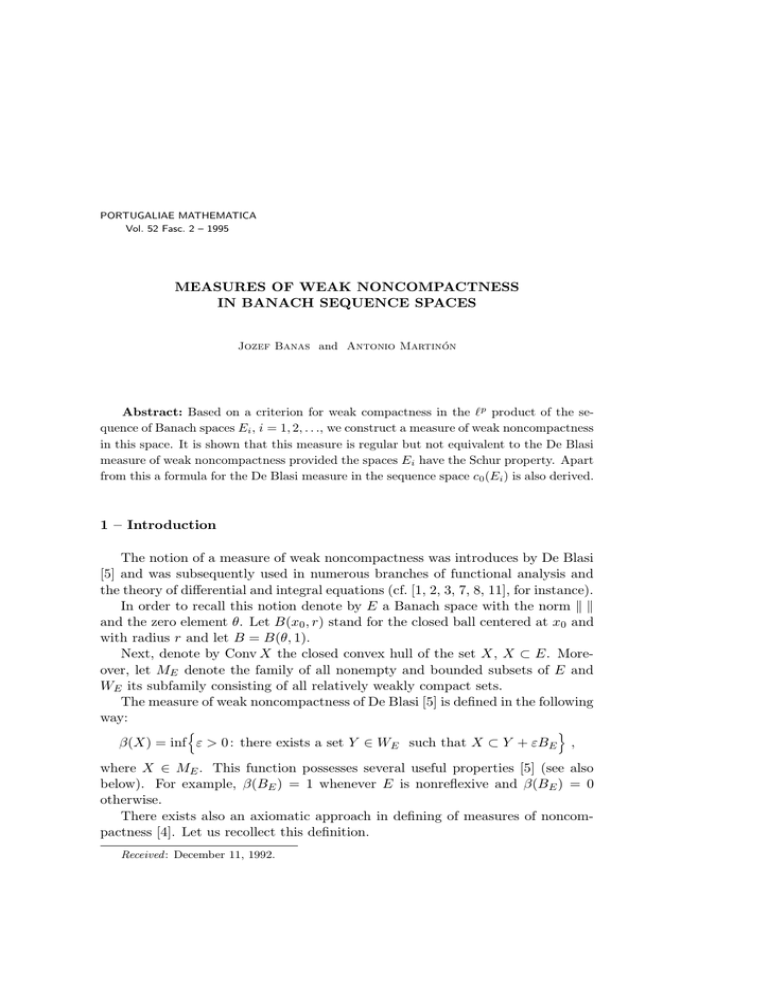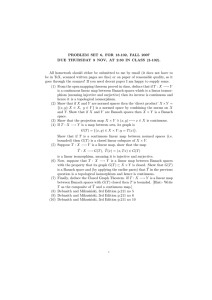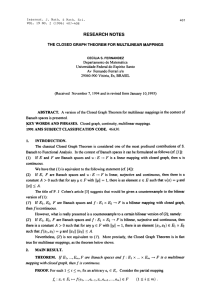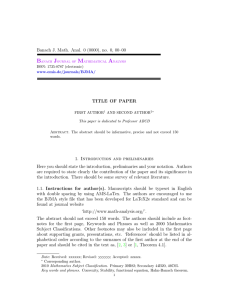MEASURES OF WEAK NONCOMPACTNESS IN BANACH SEQUENCE SPACES
advertisement

PORTUGALIAE MATHEMATICA
Vol. 52 Fasc. 2 – 1995
MEASURES OF WEAK NONCOMPACTNESS
IN BANACH SEQUENCE SPACES
Jozef Banas and Antonio Martinón
Abstract: Based on a criterion for weak compactness in the `p product of the sequence of Banach spaces Ei , i = 1, 2, . . ., we construct a measure of weak noncompactness
in this space. It is shown that this measure is regular but not equivalent to the De Blasi
measure of weak noncompactness provided the spaces Ei have the Schur property. Apart
from this a formula for the De Blasi measure in the sequence space c0 (Ei ) is also derived.
1 – Introduction
The notion of a measure of weak noncompactness was introduces by De Blasi
[5] and was subsequently used in numerous branches of functional analysis and
the theory of differential and integral equations (cf. [1, 2, 3, 7, 8, 11], for instance).
In order to recall this notion denote by E a Banach space with the norm k k
and the zero element θ. Let B(x0 , r) stand for the closed ball centered at x0 and
with radius r and let B = B(θ, 1).
Next, denote by Conv X the closed convex hull of the set X, X ⊂ E. Moreover, let ME denote the family of all nonempty and bounded subsets of E and
WE its subfamily consisting of all relatively weakly compact sets.
The measure of weak noncompactness of De Blasi [5] is defined in the following
way:
n
β(X) = inf ε > 0 : there exists a set Y ∈ WE such that X ⊂ Y + εBE
o
,
where X ∈ ME . This function possesses several useful properties [5] (see also
below). For example, β(BE ) = 1 whenever E is nonreflexive and β(BE ) = 0
otherwise.
There exists also an axiomatic approach in defining of measures of noncompactness [4]. Let us recollect this definition.
Received : December 11, 1992.
132
J. BANAS and A. MARTINÓN
Definition. A function µ : ME → R+ = [0, ∞) is said to be a measure of
weak noncompactness in E if it satisfies the following conditions:
(1) µ(X) = 0 ⇔ X ∈ WE ;
(2) X ⊂ Y ⇒ µ(X) ≤ µ(Y );
(3) µ(Conv X) = µ(X);
(4) µ(X ∪ Y ) = max{µ(X), µ(Y )};
(5) µ(X + Y ) ≤ µ(X) + µ(Y );
(6) µ(c X) = |c| µ(X), c ∈ R.
Let us mention that in the paper [4] a measure of weak noncompactness in
the above sense is called to be regular.
Notice that De Blasi measure β is a measure of weak noncompactness in this
sense and has also some additional properties [5]. However, for any measure µ
the following inequality holds [4]
(1)
µ(X) ≤ µ(BE ) β(X) .
Finally, let us recall [4] that each measure of weak noncompactness satisfies also
the Cantor intersection condition.
2 – Main results
At the beginning let us establish some notation. Assume that (Ei , k ki ),
i = 1, 2, . . ., is a given sequence of Banach spaces. Fix a number p, 1 ≤ p < ∞
and consider the set of the sequences x = (xi ) such that xi ∈ Ei for any i = 1, 2, . . .
P
p
p
p
and ∞
i=1 kxi ki < ∞. Denote this set by ` (E1 , E2 , . . .) or shortly by ` (Ei ). If
we normed it by
kxk = k(xi )k =
∞
³X
i=1
kxi kpi
´1/p
then it becomes a Banach space [10, 12].
Similarly, let c0 (Ei ) denote the space of all sequences x = (xi ), xi ∈ Ei , with
the property kxi ki → 0 as i → ∞ and endowed by the norm
n
o
kxk = k(xi )k = max kxi ki : i = 1, 2, . . . .
Further, let ek denote the canonical projection of one of the spaces `p (Ei ),
c0 (Ei ) or `p (E1 , E2 , . . . , En ) onto the space Ek , i.e. ek (x1 , x2 , . . .) = xk . Observe
that ek (Bp ) = ek (B0 ) = BEk , where Bp = B`p (Ei ) and B0 = Bc0 (Ei ) .
133
BANACH SEQUENCE SPACES
In what follows we shall need the following theorem.
Theorem 1. A subset X of the space `p (Ei ), 1 < p < ∞, is relatively weakly
compact if and only if
(a) X is bounded;
(b) the set ek (X) is relatively weakly compact in Ek for any k = 1, 2, . . . .
This theorem comes from [12], where the case Ek = E, k = 1, 2, . . ., was
investigated. Reapeting step by step the reasoning from [12] we can easily obtain
the proof of Theorem 1.
In order to define measures of weak noncompactness in the space `p (Ei ) let
us assume that βi is De Blasi measure in the space Ei , i = 1, 2, . . . and let βp
denote De Blasi measure in `p (Ei ). Further, for X ∈ M`p (Ei ) let us put
(2)
n
o
µ(X) = sup βn (en (X)) : n = 1, 2, . . . .
Then we have the following theorem.
Theorem 2. The function µ is a measure of weak noncompactness in the
space `p (Ei ), 1 < p < ∞, such that µ(X) ≤ βp (X) for any X ∈ M`p (Ei ) .
Proof: Notice first that when all the spaces Ei are reflexive then `p (Ei )
is also reflexive [10], so in view of Theorem 1, we have that µ(X) = 0 for any
X ∈ M`p (Ei ) .
Let us suppose that at least one of the space Ei is nonreflexive. Then taking
into account the properties of the function β we can easily infer that the function
µ satisfies all the conditions of our Definition (in fact, the condition (1) is a
consequence of Theorem 1).
Finally, let us notice that βk (ek (Bk )) = βk (BEk ) = 1 at least for one natural
number k. Thus we deduce that µ(Bp ) = 1 and by (1) we obtain that µ(X) ≤
βp (X). This complete the proof.
In the sequel we are going to show that the measure of weak noncompactness
defined by (2) has not to be equivalent to De Blasi measure βp .
First, let us recall that a Banach space E is said to have Schur property if
weakly convergent sequences in E are norm convergent. For example, the classical
space `1 has this property [6].
In what follows we shall need the following two lemmas.
Lemma 1. Let E be a Banach space having Schur property. Then a set
X ⊂ E is weakly compact if and only if X is compact.
134
J. BANAS and A. MARTINÓN
Lemma 2. Let E1 , E2 , . . . , En be Banach spaces with Schur property. Then
the space `p (E1 , E2 , . . . , En ) has also Schur property for 1 ≤ p < ∞.
We omit trivial proofs of the lemmas.
Starting from now on let us assume that (Ei , k ki ) is a sequence of Banach
spaces being nonreflexive and such that every space Ei has Schur property. Then
we have the following theorem.
Theorem 3. Under the above assumptions the measure of weak noncompactness µ in the space `p (Ei ) defined by (2) is not equivalent to De Blasi measure
βp (1 < p < ∞).
Proof: Suppose the contrary. Then there exists a constant c > 0 such that
(3)
c βp (X) ≤ µ(X)
for any X ∈ M`p (Ei ) .
Now, consider the sequence (Xn ) of subsets of `p (Ei ) having the form
n
Xn = x = (x1 , x2 , . . . , xn , θ, θ, . . .) : x1 ∈ BE1 , . . . , xn ∈ BEn
o
,
for n = 1, 2, . . . . Obviously we can write
Xn = BE1 × BE2 × . . . × BEn × {θ} × {θ} × . . .
which implies that we can treat Xn ⊂ `p (E1 , E2 , . . . , En ). Particularly we have
that ei (Xn ) = BEi (i = 1, 2, . . . , n) and consequently
µ(Xn ) = 1
for n = 1, 2, . . .. Thus, in virtue of (3) we get
(4)
βp (Xn ) ≤ 1/c
for n = 1, 2, . . . .
1/p − (2/c) > 0 and take ε > 0
Further, let us choose
´an integer n such that n
³
such that n1/p − 2 1c + ε > 0. By (4) we can find a relatively weakly compact
set Wn in the space `p (Ei ) such that
Xn ⊂ W n +
µ
1
+ ε B`p (Ei ) .
c
¶
In view of the remark made before, instead of the above inclusion we may write
(5)
X n ⊂ Wn +
µ
1
+ ε B`p (E1 ,E2 ,...,En ) ,
c
¶
135
BANACH SEQUENCE SPACES
where Wn is treated as a relatively weakly compact set in the space
`p (E1 , E2 , . . . , En ).
Now, fix arbitrarily i, 1 ≤ i ≤ n. In view of generalized version of Riesz
lemma [9] we can select a sequence (xik ) ⊂ BEi such that
kxik − xim k > 1
(6)
for k 6= m, k, m = 1, 2, . . . and for every i = 1, 2, . . . , n.
Next, consider the sequence (yk )k∈IN of points from Xn of the form
yn = (x1k , x2k , . . . , xnk , θ, θ, . . .) ,
k = 1, 2, . . . . Taking k 6= m and keeping in mind (6) we derive
kyk − ym k = kyk − ym k`p (E1 ,E2 ,...,En ) =
n
³X
kxik − xim kpi
i=1
´1/p
> n1/p .
On the other hand in view of (5) we can find wk ∈ Wk and zk ∈ B`p (E1 ,E2 ,...,En )
(for any k = 1, 2, . . .) such that
yk = w k +
µ
1
+ ε zk .
c
¶
Hence, taking k 6= m we obtain
kwk − wm k`p (E1 ,...,En )
°
°
¶
µ
°
°
1
°
= °(yk − ym ) −
+ ε (zk − zm )°
°p
c
` (E1 ,...,En )
¶
µ
≥ kyk − ym k`p (E1 ,...,En ) −
>n
1/p
−
µ
1
+ ε kzk − zm k`p (E1 ,...,En )
c
1
+ ε kzk − zm )k`p (E1 ,...,En ) .
c
¶
Consequently
kwk − wm k`p (E1 ,...,En ) > n
1/p
1
−2
+ε >0
c
µ
¶
for k, m = 1, 2, . . ., k 6= m.
Thus we lead to a contradiction because in view of Lemmas 1 and 2 the set W k
is relatively compact in the space `p (E1 , E2 , . . . , En ). This complete the proof.
In the sequel we shall deal with a measure of weak noncompactness in the space
c0 (Ei ). Similarly as before let βk denote De Blasi measure in Ek (k = 1, 2, . . .)
136
J. BANAS and A. MARTINÓN
and β0 stand for this measure in the space c0 (Ei ). For further purposes denote
by dk the operator acting from c0 (Ei ) into itself defined by
dk (x) = dk (x1 , x2 , . . .) = (θ, θ, . . . , θ, xk , xk+1 , . . .) .
Finally, define for X ∈ Mc0 (Ei ) :
n
o
a(X) = sup βn (en (X)) : n = 1, 2, . . . ,
n
o
b(X) = inf β0 (dn (X)) : n = 1, 2, . . . ,
n
o
γ(X) = max a(X), b(X) .
Then we have the following theorem.
Theorem 4. β0 (X) = γ(X).
Proof: Let us take an arbitrary number r > γ(X). Then there exists a
positive integer n such that
β0 (dn (X)) < r
which implies that we can choose a subset W ∈ Wc0 (Ei ) with the property
(7)
dn (X) ⊂ W + rB0 .
Without loss of generality we can assume that W = dn (W ).
On the other hand βk (ek (X)) < r for any k = 1, 2, . . . , n − 1 which allows us
to deduce that there is Wk = WEk such that
(8)
ek (X) ⊂ Wk + rBEk
for k = 1, 2, . . . , n − 1.
Now, keeping in mind (7) and (8) we infer that
³
´
X ⊂ (W1 + rBE1 ) × · · · × (Wn−1 + rBEn−1 ) × {θ} × · · · + W + rB0
and consequently
³
´
x ⊂ W1 × W2 × · · · × Wn−1 × {θ} × · · · + W + rB0 .
Hence, by the properties of De Blasi measure we have
β0 (X) ≤ r
which means that
β0 (X) ≤ γ(X) .
BANACH SEQUENCE SPACES
137
In order to show the converse inequality take r > β0 (X). Then we can find a
set W ∈ Wc0 (Ei ) such that X ⊂ W + rB0 . Hence we have
βn (en (X)) ≤ βn (en (W )) + r βn (en (B0 )) ≤ r
for n = 1, 2, . . . . Consequently
a(X) ≤ r ,
b(X) ≤ r ,
which gives the desired inequality and ends the proof.
Let us notice that dn (X) ⊃ dk (X) for n ≤ k which implies that
b(X) = lim β0 (dn (X)) .
n→∞
Finally observe that from Theorem 4 we obtain the following criterion for
weak compactness in the space c0 (Ei ).
Corollary 1. A subset X of the space c0 (Ei ) is relatively weakly compact
if and only if
(i) X is bounded,
(ii) the set ek (X) is relatively weakly compact in Ek for any k = 1, 2, . . .,
and
(iii) for any ε > 0 there exists a positive integer n0 such that β0 (dn (X)) ≤ ε
for n ≥ n0 .
Corollary 2. Let X be a subset of the space c0 (Ei ) satisfying the conditions
(i), (ii) of Corollary 1 and instead of (iii) the following one
h
h
(iv) lim sup max{kxk kk : k ≥ n}
n→∞ x∈X
ii
= 0.
Then X is relatively weakly compact.
Indeed, notice that
h
n
sup max kxk kk : k ≥ n
x∈X
oi
= kdn (X)k .
Thus in view of the inequality
β0 (dn (X)) ≤ kdn (X)k
we infer that X satisfies the condition (iii) of Corollary 1.
138
J. BANAS and A. MARTINÓN
REFERENCES
[1] Appell, J. and De Pascale E. – Su alcuni parametri connesi con la misura di
non compatteza di Hausdorff in spazi functioni misurabili, Boll. Un. Mat. Ital., 6,
3–13 (1984), 497–515.
[2] Astala, K. – On measures of noncompactness and ideal variations in Banach
spaces, Ann. Acad. Sci. Fenn. Ser. A.I. Math. Diss., 29 (1980).
[3] Astala, K. and Tylli, H.O. – Seminorms related to weak compactness and to
Tauberian operators (preprint).
[4] Banas, J. and Rivero, J. – On measures of weak noncompactness, Ann. Mat.
Pura Appl., 151 (1988), 213–224.
[5] De Blasi, F.S. – On a property of the unit sphere in a Banach space, Bull. Math.
Soc. Sci. Math. R.S. Roumanie, 21 (1977), 259–262.
[6] Diestel, J. – Sequences and series in Banach spaces, Springer Verlag, 1984.
[7] Emmanuele, G. – Measure of weak noncompactness and fixed point theorems,
Bull. Math. Soc. Sci. Math. R.S. Roumanie, 25 (1981), 353–358.
[8] Gonzalez, M. and Martinon, A. – On the generalized Sadovskii functor, Rev.
Acad. Canaria Cien., 1 (1990), 109–117.
[9] Kottman, C.A. – Subsets of the unit ball that are separated by more than one,
Studia Math., 53 (1975), 15–27.
[10] Köthe, G. – Topological vector spaces I, Springer Verlag, 1969.
[11] Lakshmikantham, V. and Leela, S. – Nonlinear differential equations in abstract spaces, Pergamon Press, 1981.
[12] Leonard, I.E. – Banach sequence spaces, J. Math. Anal. Appl., 54 (1976), 245–
265.
Jozef Banas,
Department of Mathematics, Technical University of Rzeszów,
35-959 Rzeszów, W. Pola 2 – POLAND
and
Antonio Martinón,
Department of Mathematical Analysis, University of La Laguna,
38271 La Laguna (Tenerife) – SPAIN



